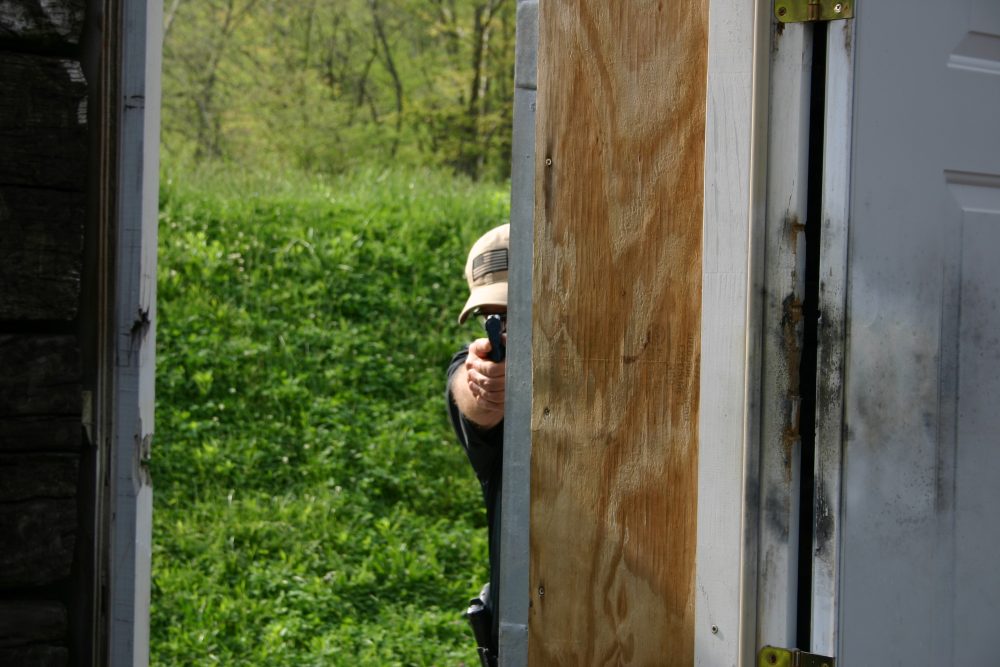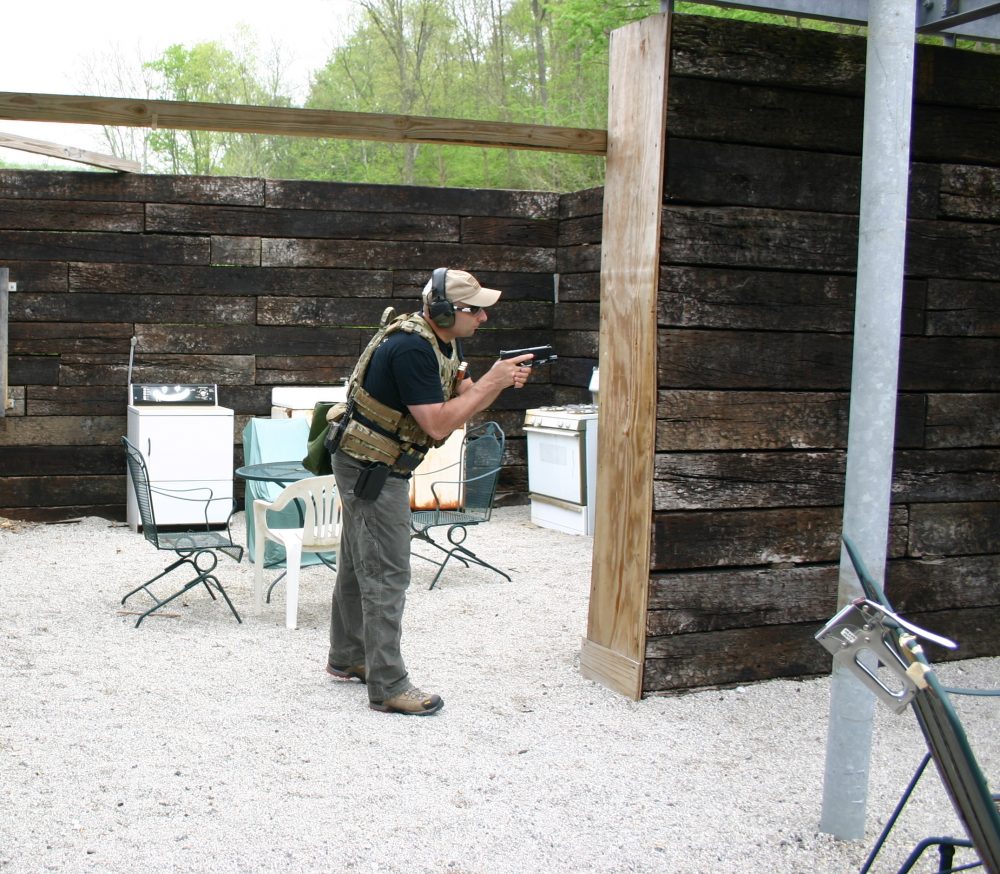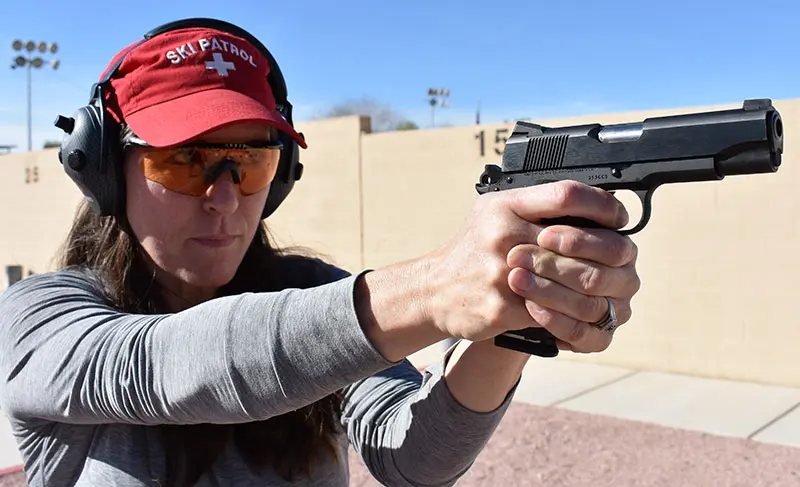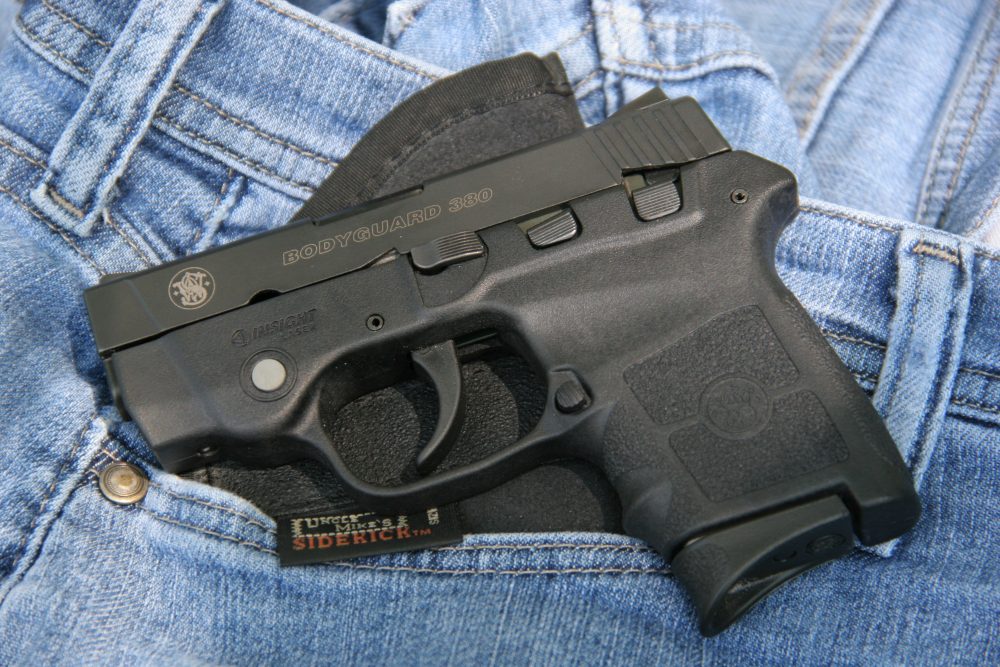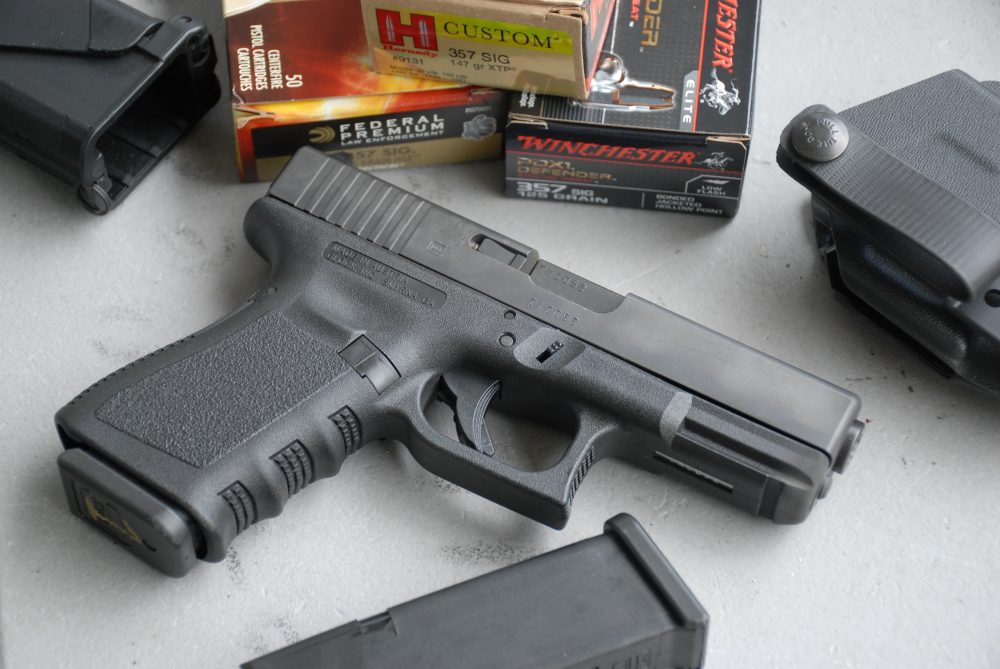Many people think of home defense as barricading themselves in their bedroom with their family while calling the police and covering the bedroom door with their firearm, ready to shoot any intruders who attempt to crash through. However, few have planned or practiced how to safely get those family members into their bedroom, or considered if doing so is even feasible during a home invasion.
It’s also not practical, possible or desirable to call the police every time you hear a suspicious sound. If you do, the police will eventually stop responding, or accord your calls the severity of a barking dog report.
There is a huge difference between a strange noise and the sound of your door being kicked in. Realizing this, many people find themselves investigating suspicious sounds all the time. But knowing how to do so correctly requires a course all in itself.
Table of Contents
THE COURSE
With this in mind, Ken Hackathorn developed a home-defense course that utilizes a live-fire shoot house. The course covers everything from investigating a sound in the night to searching for possible intruders to countering a home invasion.
This course differs from most shoot house courses, where you go in as part of a team, because at home you will likely be alone. The way you defend and clear your own home is vastly different than how a military or police team would make an entry.
Instructor demonstrates shooting while maximizing doorway cover.
Ken Hackathorn’s background would take an article in itself to cover. He has been instructing for almost 40 years and has provided training to some of the most elite military and police units in the U.S. as well as the world. He served as a weapons instructor in the U.S. Military and spent many years as an Ohio Sheriff, where he served on their SRT Team and ultimately was responsible for their training.
For this course, Ken was assisted by the Castle Group, which is composed of several of his long-time students whom he has carefully selected to carry on instructing this course after he has moved out of the area and will no longer have easy access to the shoot house.
The class was definitely not for beginners. Students needed to have a solid grounding in firearm handling and shooting already.
The course took place in Marietta, Ohio, at the Fort Harmar Rifle Club’s shoot house. Though the building’s double railroad tie thick walls could stop all handgun rounds, Ken reminded us that this is not the case with walls in our homes in the real world—a factor we would have to consider if we ever needed to use a firearm for home defense.
After clearing main rooms, student edges down hallway.
SHOOT HOUSE OR SHOOT HOME?
The shoot house’s interior consisted of a large main room split into a living room and kitchen/dining area, and a long, narrow hallway with two rooms on each side.
Before we did anything in the shoot house with live ammo, we practiced firing on the adjacent square range and then did walk throughs of the shoot house with blue guns. When it came time to navigate the shoot house, we did so individually with Ken or one of his assistant instructors right behind us and another observing from above on the catwalk.
Within the house were cardboard IPSC targets that were hidden from sight until you advanced to certain points. Some had weapons painted on them, signifying hostiles. Others had hands painted on with their palms facing out, indicating friendlies. At night, we relied on a system of different colored bandannas wrapped around the targets’ necks to signify friendly or hostile. The positions of the shoot and don’t-shoot targets were shifted throughout the course.
To make maximum use of the training time and resources, the shoot house was stocked with more targets than most people would face in a typical home defense scenario.
Soft body armor was required for entering the shoot house or observing from the catwalk. Loaner armor was available to students who did not have their own. When on the catwalk, instructors made sure to keep the students observing parallel to or behind the student who was navigating the shoot house below.
Ken Hackathorn demonstrates use of maximum cover while employing third eye principle.
HACKATHORN’S PREFERENCES
Ken favors employing the third eye principle, where the gun is moved as though it were a third eye tied to your other two, so that the muzzle is in fairly close proximity to where you are looking.
One thing that Ken was adamant about was not just keeping the trigger finger off the trigger when not ready to shoot, but keeping the trigger finger on the ejection port, thus providing a positive reference point.
We were instructed to fire three rounds minimum per target. Ken observed that many failures to stop with multiple rounds were a result of peripheral hits. This is why Ken favors a quality high-capacity 9mm handgun, as they allow you to engage multiple attackers with multiple rounds. In a home defense situation, you may be in your pajamas and not carrying a spare magazine, and therefore limited to the number of rounds in the gun.
For this reason, Ken did not believe in dropping any magazines with rounds in them for this class. If you did run out of ammo and had to reload, it was incidental.
Ken prefers a handgun over a long arm for home defense. A handgun is easier to keep on or nearby your person and can be easily hidden and quickly brought into play. A handgun allows you to effectively operate with one hand if necessary, whether to call the police, open an interior doorknob or move a family member, tasks that may require the use of a hand.
Whether held in one hand or two, the handgun can be compressed back so that you can immediately fire on a suddenly approaching attacker as you pie a doorway. This may be necessary to handle tight indoor spaces, and students frequently found themselves doing this, as opposed to using the more extended arm positions that people typically employ on a shooting range.
Ken observes as student engages target.
PRE-INVASION CONSIDERATIONS
Ken covered other areas such as home hardening, like selecting good locks and solid doors. Most bedroom doors and locks are flimsy, and thus barely provide a speed bump once an invader is inside your house.
Hackathorn discussed the limitations of home alarms—namely that the response time is such that even in the best circumstances, you could not expect help to arrive in time. Many people don’t leave their alarm on when they are home during the day and only turn it on when they are going to bed or out. Thus the alarm will not be a factor many times when home invasions occur, depriving the resident of a valuable early warning resource.
The most common method that home invaders use to gain access is by knocking on the door or ringing the bell. Too many people simply open the door without checking who it is, only to have home invaders rush in. Even when the homeowner does not open the door right away, home invaders will attempt to use deception to convince the homeowner to open the door.
Thus two of the most important strategies to combat home invasions are to have strong doors, strong locks and other structural hardening, and to not open the door for anyone whom you are not 100% certain about—and make sure other household members do the same.
Student engages hostile target hidden in corner.
SHOOTIN’ TIME
We began the class with some work on the range adjacent to the shoot house and built up from there. Throughout the course, we alternated between the range and the shoot house, introducing skills on the range that we would need in the shoot house, such as shooting around cover. Ken stressed trying to keep as much of yourself as possible behind cover or concealment, and leaning your upper body out to the side no more than necessary to search or make the shot. This allows you to pick up the edge of a target while minimizing your exposure. Once you know the location of the target, you can lean out farther to identify it and engage it if hostile.
Many people had a hard time translating this to the shoot house. The common response when picking up a target was to step out and square with the target in order to engage it from a comfortable balanced shooting stance. Ken warned against this, as doing so would expose more of you for the hostile to shoot. Standing in an open doorway is like standing in a target frame, Ken cautioned. He referred to this as “dueling” with the target.
Whenever someone in the class did this in the shoot house, Ken or whichever instructor was behind us immediately called our attention to it and then made us re-engage the target correctly. They also stopped us immediately whenever we entered a room incorrectly, pointed out our mistakes, and made us redo it the right way.
This immediate feedback was much more effective than telling us after we’d completed our run through the shoot house, when we might not remember precisely how we did something.
Student leans in from doorframe to engage target while minimally exposing himself.
PROPER MOVEMENT THROUGH STRUCTURES
The blue-gun walk throughs were essential for practicing proper movement through a structure. Whether searching or checking, you must move slowly, minimize your sound signature, and use cover and concealment to present the smallest possible target to a hostile.
We were taught to pie when searching an area that was blocked from view, be it around a corner or a room on the other side of a doorway. When pieing, maintain distance from any obstacle or cover and move laterally a bit at a time so you can hopefully spot the edge of someone being concealed and know where they are before they become aware of your presence.
We covered the correct way to open a door by yourself, and how to slowly pie the doorway from the outside to minimize your exposure while checking inside the room for hostile targets.
When entering, we were advised to occupy a nearby corner, because from this position the room will represent a 90-degree arc for you to observe, as opposed to a 180-degree arc if your back were to the wall. Ken referred to this position as a point of domination—a position from which you can fight or defend from where you have the least angle and least amount of area to observe.
Ken pointed out that depending on the situation, moving to a position of domination where you can deny a home invader deeper penetration into your home and protect your family might be as far as you need to take it.
We were warned not to turn our back on any area we had not searched. This often determined which side of a closed door we stood on when we reached to open the knob.
LOW-LIGHT TECHNIQUES
We spent the first day making runs through the shoot house, then broke for dinner. After we returned from dinner, Ken and the Castle Group instructors went over night-firing techniques—both with flashlights and weapon-mounted lights.
We covered several methods of using a handheld flashlight along with our handguns. While Ken prefers the Harries method, he pointed out that it will not work well when used by a right hander around right-side cover, because the light will flash off the nearby cover into your eyes and disrupt your vision. The key to using the light was to use it as sparingly as possible, just briefly on and off in flashes.
The most important use of light, Ken stressed, was in positively identifying your target before shooting.
Ken considers handgun-mounted lights much more effective, as they allow the user to fire the handgun from a two-handed grip. He recommended people equip their home defense handguns with them. Ken and the instructors provided loaner handgun-mounted lights to any students who did not have their own.
Ken familiarizes student with Beretta Storm Carbine.
NIGHT SHOOT
After we practiced night-firing techniques on the adjacent range, we moved to the shoot house. First we worked with handheld flashlights, then proceeded through with gun-mounted lights. Everyone found the gun-mounted lights easier to use and easier to engage the target while firing.
Ken warned that after firing a few shots with a handheld light, the light and the gun might not be pointing parallel, especially when firing from the angled and compressed positions we often found ourselves using inside the shoot house. The tendency, he advised, is to try to fire where the light is pointing.
I found myself in a situation where my light was not pointed at the silhouette I was engaging after my first shot. But I had already used the light to positively ID the target as a hostile, so even though the light was not directly pointed at the target, it served to illuminate my underperforming night sights and allow me to successfully engage the target.
LONG GUNS FOR HOME DEFENSE
On the second day of class, Ken introduced the use of long arms. Since the shoot house was only rated for pistol caliber, we used a Beretta 9mm Storm and Colt 9mm carbine.
Before we proceeded through the shoot house, we practiced firing these guns around barricades. This included switching hands to minimize our exposure. While Ken considered this the optimal way to minimize exposure, he pointed out that most people would need a great deal of regular practice before they could employ this method in real life. Under stress, he explained, you will only attempt what you are confident you can achieve or what you can perform on a subconscious level.
CLOSING SCENARIO
The class ended with a home invasion scenario where each student was sitting in a chair with a loaded gun in a nearby drawer and had to retrieve the gun and safely get to a point of domination. This simulated responding to a kicked-in door, where intruders had burst into another part of your house and you had to move fast because the farther into your house they advanced, the greater the threat to your family. Here your goal is to block the invaders and deny them depth of penetration in your home. You want to get to a defensible position where you can stand between them and your family members.
The instructors stressed that what they presented were options with caveats, and this course gave us the fundamentals of a defensive house clearing. When we got home after the course, they advised us to review our homes with an eye toward possible points of domination and how we would clear them, and urged us to practice doing so. Ken cautioned us not to let ourselves revert to bad habits. Proficiency requires constant practice.
Ken and the Castle Group instructors are providing the training to maximize your chances of survival and presenting options should fate force your hand in a home invasion. Without this training, Ken stresses that you should not leave your bedroom unless you have no choice.
I would rather have the choice and the training.
SOURCE:
Castle Defense LLC
(740) 525-0225
www.castledefensellc.com
